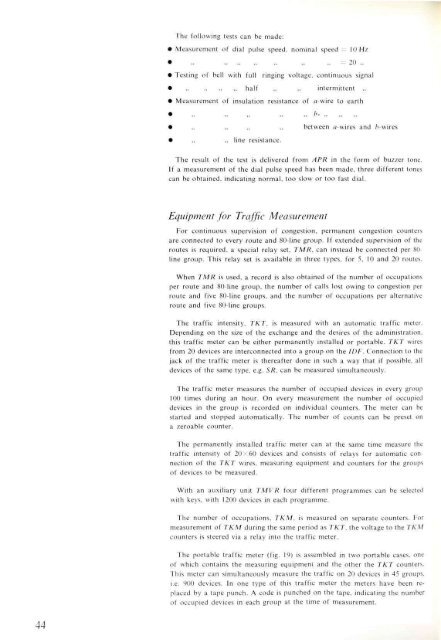The Ericsson Group 1968 - History of Ericsson - History of Ericsson
The Ericsson Group 1968 - History of Ericsson - History of Ericsson
The Ericsson Group 1968 - History of Ericsson - History of Ericsson
Create successful ePaper yourself
Turn your PDF publications into a flip-book with our unique Google optimized e-Paper software.
44<br />
<strong>The</strong> following tests can be made:<br />
• Measurement <strong>of</strong> dial pulse speed, nominal speed — 10 Hz<br />
• ,. „ „ ,. ,. „ „ = 20 ,.<br />
• Testing <strong>of</strong> bell with full ringing voltage, continuous signal<br />
• half ,, ,, intermittent ,,<br />
• Measurement <strong>of</strong> insulation resistance <strong>of</strong> a-wire to earth<br />
• „ „ „ ., b-<br />
• ,. ,, „ „ between a-wires and /'-wires<br />
• ,, ., line resistance.<br />
<strong>The</strong> result <strong>of</strong> the test is delivered from APR in the form <strong>of</strong> buzzer tone.<br />
If a measurement <strong>of</strong> the dial pulse speed has been made, three different tones<br />
can be obtained, indicating normal, too slow or too fast dial.<br />
Equipment for Traffic Measurement<br />
For continuous supervision <strong>of</strong> congestion, permanent congestion counters<br />
are connected to every route and 80-line group. If extended supervision <strong>of</strong> the<br />
routes is required, a special relay set, TMR, can instead be connected per 80line<br />
group. This relay set is available in three types, for 5. 10 and 20 routes.<br />
When TMR is used, a record is also obtained <strong>of</strong> the number <strong>of</strong> occupations<br />
per route and 80-line group, the number <strong>of</strong> calls lost owing to congestion per<br />
route and five 80-line groups, and the number <strong>of</strong> occupations per alternative<br />
route and five 80-line groups.<br />
<strong>The</strong> traffic intensity, TKT, is measured with an automatic traffic meter.<br />
Depending on the size <strong>of</strong> the exchange and the desires <strong>of</strong> the administration,<br />
this traffic meter can be either permanently installed or portable. TKT wires<br />
from 20 devices are interconnected into a group on the IDF. Connection to the<br />
jack <strong>of</strong> the traffic meter is thereafter done in such a way that if possible, all<br />
devices <strong>of</strong> the same type, e.g. SR, can be measured simultaneously.<br />
<strong>The</strong> traffic meter measures the number <strong>of</strong> occupied devices in every group<br />
100 times during an hour. On every measurement the number <strong>of</strong> occupied<br />
devices in the group is recorded on individual counters. <strong>The</strong> meter can be<br />
started and stopped automatically. <strong>The</strong> number <strong>of</strong> counts can be preset on<br />
a zeroable counter.<br />
<strong>The</strong> permanently installed traffic meter can at the same time measure the<br />
traffic intensity <strong>of</strong> 20 • 60 devices and consists <strong>of</strong> relays for automatic connection<br />
<strong>of</strong> the TKT wires, measuring equipment and counters for the groups<br />
<strong>of</strong> devices to be measured.<br />
With an auxiliary unit TMVR four different programmes can be selected<br />
with keys, with 1200 devices in each programme.<br />
<strong>The</strong> number <strong>of</strong> occupations, TKM, is measured on separate counters. For<br />
measurement <strong>of</strong> TKM during the same period as TKT, the voltage to the TKM<br />
counters is steered via a relay into the traffic meter.<br />
<strong>The</strong> portable traffic meter (fig. 19) is assembled in two portable cases, one<br />
<strong>of</strong> which contains the measuring equipment and the other the TKT counters.<br />
This meter can simultaneously measure the traffic on 20 devices in 45 groups,<br />
i.e. 900 devices. Jn one type <strong>of</strong> this traffic meter the meters have been replaced<br />
by a tape punch. A code is punched on the tape, indicating the number<br />
<strong>of</strong> occupied devices in each group at the time <strong>of</strong> measurement.
















